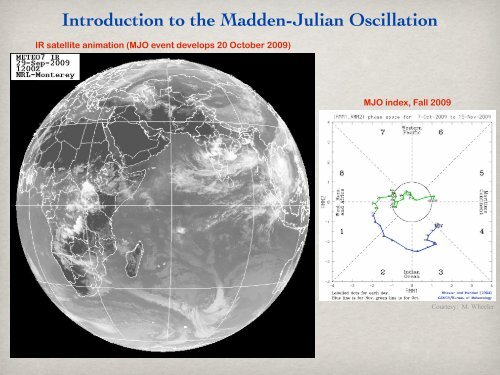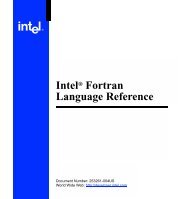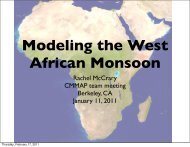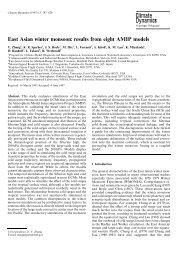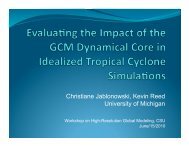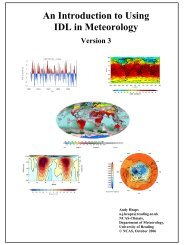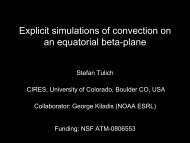Introduction â The MJO
Introduction â The MJO
Introduction â The MJO
Create successful ePaper yourself
Turn your PDF publications into a flip-book with our unique Google optimized e-Paper software.
<strong>Introduction</strong> to the Madden-Julian Oscillation<br />
IR satellite animation (<strong>MJO</strong> event develops 20 October 2009)<br />
<strong>MJO</strong> index, Fall 2009<br />
Courtesy: M. Wheeler
Road Map<br />
• <strong>Introduction</strong> — <strong>The</strong> <strong>MJO</strong> and its environment<br />
• What initiates the <strong>MJO</strong>?<br />
• What maintains the <strong>MJO</strong>?<br />
• <strong>The</strong> <strong>MJO</strong> in global climate models
Road Map<br />
• <strong>Introduction</strong> — <strong>The</strong> <strong>MJO</strong> and its environment<br />
• What initiates the <strong>MJO</strong>?<br />
• What maintains the <strong>MJO</strong>?<br />
• <strong>The</strong> <strong>MJO</strong> in global climate models
Tropical Weather 101<br />
• Small Coriolis force ➞<br />
strong gradients cannot persist ➞<br />
small variations in temperature and<br />
pressure<br />
Long-term mean January<br />
1000-500 hPa thickness<br />
• Latent heating is of primary importance<br />
• Balanced locally (adiabatic cooling) and<br />
globally (radiative cooling)<br />
• Local heating perturbations are<br />
communicated through tropical<br />
atmosphere via equatorial waves<br />
RICO field experiment, Caribbean Sea, 2005
Tropical Weather 101<br />
• Equatorial waves are often classified by their spatial scale and frequency/period:<br />
Equatorial Rossby wave (n=1)<br />
L<br />
L<br />
Kelvin wave<br />
H<br />
L<br />
Matsuno 1966<br />
Matsuno 1966
Tropical Weather 101<br />
• Another equatorial wave type: <strong>The</strong> Madden-Julian Oscillation (<strong>MJO</strong>)<br />
“We stumbled upon an apparent long-period<br />
oscillation in the station pressure and zonal<br />
wind components at Canton Island.”<br />
- Madden and Julian 1971<br />
Heating<br />
Gill 1980
What is the <strong>MJO</strong>?<br />
• <strong>MJO</strong> dominates equatorial atmospheric variability on<br />
intraseasonal timescales (20-100 days)<br />
• Disturbance propagates eastward at ~5 m/s from Indian into<br />
Pacific Ocean<br />
• Convective signal dissipates near 180°E, dynamical signal<br />
(“dry” Kelvin wave) continues eastward at ~30 m/s<br />
Regressed OLR and 850 hPa wind anomalies
Background & Motivation 1: Impacts<br />
<strong>The</strong> <strong>MJO</strong> strongly influences...<br />
• Regional and global weather and climate patterns:<br />
• Asian, Australian monsoons<br />
• ENSO<br />
• Teleconnections - midlatitude weather, tropical cyclone distribution/frequency,<br />
polar oscillations<br />
• Earth’s rotation rate<br />
(length of day)<br />
Arctic Oscillation<br />
Rossby wave trains<br />
Asian Monsoon<br />
• Atmospheric and oceanic<br />
chemistry:<br />
<strong>The</strong> <strong>MJO</strong><br />
Slow moist Kelvin-Rossby wave<br />
Australian Monsoon<br />
(in northern summer)<br />
(ENSO)<br />
Fast dry Kelvin Wave<br />
• Ozone<br />
• Aerosols<br />
Rossby wave trains<br />
Antarctic Oscillation<br />
• Chlorophyll<br />
Tropical Cyclone<br />
Storm<br />
Courtesy: Kate Thayer-Calder, adapted from Lin et al. 2006
Background & Motivation 2: Challenges<br />
ECMWF Analysis & Forecast,<br />
200 hPa Velocity Potential<br />
• Inability to accurately and consistently<br />
reproduce <strong>MJO</strong> in GCMs<br />
• Inadequate understanding of key<br />
mechanisms<br />
• Initiation, eastward propagation, scale<br />
interactions, tropical-extratropical<br />
interactions, topographic effects<br />
• Limited predictive skill (< 15 days)<br />
Courtesy: Moncrieff, Tompkins<br />
• Lack of in situ measurements<br />
2003 radiosonde stations, NCDC
Road Map<br />
• <strong>Introduction</strong> — <strong>The</strong> <strong>MJO</strong> and its environment<br />
• What initiates the <strong>MJO</strong>?<br />
• What maintains the <strong>MJO</strong>?<br />
• <strong>The</strong> <strong>MJO</strong> in global climate models
What Triggers <strong>MJO</strong> Convection?<br />
Main question: When does convection become organized, and how does this occur?<br />
Potential triggers<br />
1. Extratropical forcing Matthews and Kiladis 1999<br />
2. Circumnavigating signal Knutson and Weickmann 1987, Matthews 2008<br />
3. Stochastic forcing Yu and Neelin 1994<br />
4. Discharge-recharge mechanism* Bladé and Hartmann 1993,<br />
Kemball-Cook and Weare 2001
Road Map<br />
• <strong>Introduction</strong> — <strong>The</strong> <strong>MJO</strong> and its environment<br />
• What initiates the <strong>MJO</strong>?<br />
• What maintains the <strong>MJO</strong>?<br />
• <strong>The</strong> <strong>MJO</strong> in global climate models
<strong>MJO</strong> Maintenance and Propagation<br />
Main questions<br />
1. How is <strong>MJO</strong> convection maintained against dissipation?<br />
An area favorable for convection must be established/maintained.<br />
2. How and why does the <strong>MJO</strong> move eastward?<br />
That “convection-friendly” area must lead and accompany the <strong>MJO</strong>.
<strong>MJO</strong> Maintenance and Propagation<br />
Primary building blocks of <strong>MJO</strong> instability theory<br />
1. Conditional Instability of the Second Kind associated with<br />
large-scale waves (wave-CISK)<br />
2. Convection-wind-evaporation feedback
<strong>MJO</strong> Maintenance and Propagation<br />
(1) WAVE-CISK<br />
• Cooperation between localized convective heating and its environmental<br />
circulation
<strong>MJO</strong> Maintenance and Propagation<br />
(2) WIND-INDUCED SURFACE HEAT EXCHANGE (WISHE)<br />
• Secondary circulation superimposed onto background easterly flow<br />
generates larger evaporative fluxes to east of convection and promotes<br />
eastward progression of convection<br />
Adapted from Straub and Kiladis 2003
<strong>MJO</strong> Maintenance and Propagation<br />
“Updated” wave-CISK:<br />
Frictional convergence feedback<br />
Wave-CISK component<br />
Height: 3000 m<br />
Height: 500 m<br />
BL drying<br />
BL moistening<br />
Frictional convergence<br />
component<br />
V<br />
Coriolis<br />
Coriolis<br />
V<br />
Friction<br />
Pressure<br />
gradient<br />
Pressure<br />
gradient
<strong>MJO</strong> Maintenance and Propagation<br />
<strong>The</strong> “right answer” regarding an explanation of how <strong>MJO</strong><br />
convection is maintained and propagates eastward likely<br />
involves elements of many proposed theories:<br />
Convection-wind-evaporation<br />
feedback (WISHE)<br />
Wave-CISK<br />
Frictional convergence<br />
feedback<br />
Discharge-recharge<br />
mechanism<br />
Stratiform instability
Road Map<br />
• <strong>Introduction</strong> — <strong>The</strong> <strong>MJO</strong> and its environment<br />
• What initiates the <strong>MJO</strong>?<br />
• What maintains the <strong>MJO</strong>?<br />
• <strong>The</strong> <strong>MJO</strong> in global climate models
<strong>The</strong> <strong>MJO</strong> in GCMs<br />
Kim et al. 2009<br />
Key factors: mean state, rain vs. column moistening, % stratiform rain


